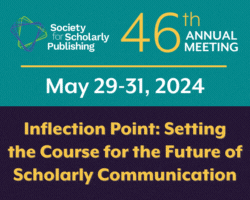Plan S promises to reshape the way scholarly publishing is accomplished, affecting authors, publishers, libraries, and everyone in between. In a refreshing twist, SSP delivers a webinar discussion that takes Plan S and the movement toward Open Access (OA) as a given. The speakers were then charged with offering business models that would suit the new access landscape.
Moderator Jason Pointe (Publishing Director, International Anesthesia Research Society) began the webinar noting that there were no slides, but rather this would be a discussion between three perspectives in publishing after their opening statements.
The first to speak was John Willinsky (Director of Public Knowledge Project, Khosla Family Professor, Stanford University) whose opening statement introduced the Subscribe to Open model. Subscribe to Open asks libraries to continue to pay existing subscription-level fees, and at the point where enough libraries sign on, the journal or portfolio can switch to full Open Access. This library-supported OA model has drawn commitments and interest from publishers and societies, and it seems like a promising way to support widespread OA without completely reshaping the industry.
The second speaker was Stephanie Diment (Director, Open Research, Wiley) who reminded us that all of Wiley’s 1,600 journals follow the hybrid model and support Open Access if authors are willing to cover the article processing charge (APC). She went on to describe Wiley’s consortia agreements, including one with Germany’s Projekt DEAL that follows the Publish and Read (PAR) model. In this model, researchers at the 700 institutions covered by the Projekt DEAL agreement have full access to read Wiley’s journals, and can publish their own primary research and review articles as Gold OA. The related fees and APCs are paid centrally by Projekt DEAL institutions. Stephanie highlighted the fact that Wiley’s PAR agreements are customized to each consortium and are designed to be sustainable and work at scale.
The third speaker was Harold Varmus, MD (Lewis Thomas University Professor, Weill Cornell Medicine, Senior Associate Member, New York Genome Center), who, in previous roles at the NIH and PLOS, has worked to promote OA through initiatives such as PubMed Central, the PLOS journals, and BioMed Central. He championed the fact that 25-30% of new research is being published OA. He was critical of publishers who do what he referred to as “double-dip,” i.e. charge both APCs and subscription fees on the same journal, and also of scientific societies for failing to sufficiently plan their finances to adapt to OA-focused models.
The speakers then fielded questions from the audience about sustainability and changing market dynamics as players adapted to the new landscape.
John reminded everyone that overall scholarly publishing costs should stay relatively stable even in an OA world, so current spending levels should be sufficient in the future. He also raised the spectre of “free riders,” the researchers or institutions that would benefit from reading OA articles while bearing none of the cost. However, through his work on Subscribe to Open agreements, he has found that very few libraries were looking for a free ride. John also suggested that humanities journals would likely face a more challenging road than those in the biomedical fields due to the stark differences in funding.
Stephanie promoted diversifying revenue streams to ensure sustainability, including starting new OA journals at both ends of the prestige spectrum, and building new tools for researchers and societies. She mentioned that Wiley was looking at the new OA publishing models with great interest as they develop their approach going forward.
Dr. Varmus called out the academic community for continuing to place outsized importance on publications in the old guard, high Impact Factor journals(e.g. Nature, Science, Cell) when making career decisions for faculty and researchers, while discounting publications in OA journals. Though he hoped for this to change, he acknowledged that even well-regarded OA journals like PLOS Medicine have thus far failed to break into people’s perceptions of what constitutes the top tier.
- “Plan S: Opportunities for the Future of Scholarly Publishing” and other webinars are available for free in the SSP library.
News contribution by SSP member, Michael Casp. Michael is the Director of Business Development and Production Services Coordinator with J&J Editorial, LLC.



Join the Conversation
You must be logged in to post a comment.